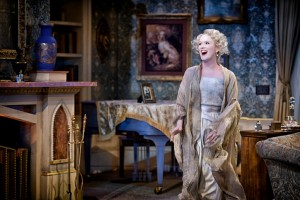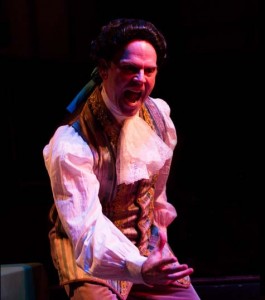Theme Songs Page | Previous Theme Song | Next Theme Song
Teaching War

Love Theme from The Winds of War and War and Remembrance, by Robert Cobert (1983), encountered ca. 2000
Buy it here | See it here | Sheet music here
Kids grow up. Lucky parents get to have fun with them as they do it. In the case of me and my young son Matthew, the route to shared fun was quickly identified – we gorged on movies and television together. Many weeknights after schoolwork we shared one or another TV series; on Friday nights we’d often frequent the multiplexes together. And this was still an era when we could patronize the neighborhood video rental store (now long gone) to fill in nights when there was nothing on. Today, Matt having inconsiderately grown up, those nights are now among my most precious memories.
Between Big Explosions and Small Ones
Our sharing didn’t mean we always gravitated towards the same things. Matt, for instance, could not get enough of special effects-heavy extravaganzas where a lot of things blew up and bad guys and good guys would shoot it out. I cared more for character-driven small films. More often than not, when our aspirations diverged, we went his route. But not always. And there was a lot of ground in the middle.
Probably the most beckoning middle ground was the area of war movies and TV. Lots of spectacular stuff there, things blowing up, and shooting. But then too lots of room for stories that plumbed the depth of the human heart and touched on big themes, not least of which were war itself and the tides of human history
Of course with a youngster, you can’t make just anything available. Saving Private Ryan, for example, is not appropriate for a 10-year-old.[1] But a lot of the best material is in a gray area. I did want us to share early the long, somewhat rambling Winds of War and War and Remembrance series, based on Herman Wouk’s novels. They were then freshly out on videotape. Yeah, there was some very grownup Holocaust material in it. (I think I may have initially skipped some of the most graphic parts.) But the more conventional war story stuff in it (sailors and soldiers getting ready for and fighting a war) carried its own challenges.
Stuff to Talk About
Those of us who grew up as I grew up, those for whom Vietnam was the specific war we defined ourselves against (as I’ve discussed here, for instance), were bound to have problems with the tone. Herman Wouk was certainly not an unqualified admirer of the military, witness his book and play The Caine Mutiny, which ultimately excuse the tyrannical Captain Queeg, but not before showing that his actions provided much to excuse.
Still, by and large, the American sailors and naval officers presented in the shows are decent types, and even the German general staff officer we get to know is more admirable than not, though of course the SS people are appropriately loathsome. But to a child of the Sixties the tone was still too worshipful. I was fully prepared to concede that World War Two was a “good war.”[2] But…. But it remains true that even the best war will provide even the best countries with opportunities and excuses to act badly, and none will completely resist those opportunities. Very little of that came through.[3] So there had to be a discussion of that.
On the other hand, the series did pretty well present the Holocaust, both the brute facts of the extermination and also the way it had appeared in real time to Americans who heard only rumors and largely disbelieved them, and whose own genteel anti-Semitism may have facilitated the killings. This was important to teach my son, whose forbears may have included my Jewish grandfather from Lithuania and Jewish grandmother from England, but whose cultural exposure to the horrors of this particular genocide would nonetheless likely be limited by the predominantly Catholic background and milieu in which he himself was being raised.[4] So we certainly had discussions about that.
Great Men?
Also, as vast as the scope of the Winds of War series was, it did tend to focus on the “Great Men” a bit too much for my taste. You know, Roosevelt and Hitler and Stalin and Churchill. Wouk’s storyline gives its hero, Pug Henry, access to each of them, and even when Henry isn’t dealing with them, we get privileged glimpses of what they’re up to. Not for Wouk the Tolstoyan view (shared by Victor Hugo) that the Great Men are actually history’s puppets. In Wouk’s book, these are leaders of great consequence whose decisions were determinative. While greatly enjoying the glimpses Winds of War gave us of these privileged leaders, Matt and I also talked through the opposing view of the Great Men.
At bottom, though, we must have surrendered emotionally to it, whatever our intellectual approach. How could we not, when their faces were presented to us at the outset of every episode, peering out of the giant letters of the title,[5] set against a background of roiling clouds, while Robert Cobert’s majestic Love Theme rolled in the background and the opening titles rolled with it?[6] Cobert, a journeyman who wrote much game show music, may not have been a John Williams or a Hans Zimmer, but this was his moment of greatness.[7] The music tells us that this is a great story, epic in scale, and full of emotion, full of heartbreak and love. Strings sing the theme over a bed of growling trombones; it is irresistible.
So we found ourserlves idolizing FDR and Winnie along with the brave Henry and Jastrow families whose stories were the primary focus.
High Chastity, Low Def
The Winds of War is also incurably old-fashioned – was old-fashioned even when it was being produced, and not just because it presented us Americans as the good guys, good with hardly a trace of the kinds of shadows Vietnam had shown must have been there even in the “good” Second World War. It was old-fashioned because of the “newsreel” introductions, with the voice of William T. Woodson announcing facts the way newsreel announcers had done, authoritatively, unhesitatingly, conveying far more effectively by their tone than through any assertions that there is only one perspective to consider – that of the omniscient white male. Again, this needed to be unpacked, and we did that together.
Perhaps the most old-fashioned thing about it was the rampant chastity at its heart. We are supposed to believe that married Pug Henry, the naval officer we follow for five years, who has an affair with a delectable British lady throughout most of that period, never beds her through all the wrack and ruin of war until he is divorced from his faithless wife and married to the Brit. Roosevelt is not a randy old goat, and he and Eleanor seem to have a fine marriage. We are supposed to disapprove of a flyer’s widow having an affair to hold her misery at bay. We are meant to pardon the British lady having a fling with an old flame only because: a) Pug isn’t ready to marry her yet; and b) the old flame is slowly dying of a tropical disease, so it’s mercy sex. Meanwhile, we are supposed to believe the hot British lady is desperately in love with Pug even though he’s portrayed by Robert Mitchum, who was twenty years too old for the part.[8] All very interesting discussions to have with a ten-year-old.
There was technical old-fashionedness too; if you view the DVD transfers available now, you can see how much less satisfying the low-density narrow-screen productions of that era were. More visual information on the screen is just more interesting. And for all the huge budget, the kinds of trompe l’oeil that any digital effects shop would endow any war movie with today are simply missing.
Evenings of Discussion
In short, we were looking at an artifact together, Matt and I, one whose flaws were as instructive as its achievements. So much to talk about. Now, when I hear those sinking cadences of the main title (which I play for myself occasionally), I remember those evenings of discussion, and wish I could go back. I’d like to think my son, who grew up to be a maker of videos and blogger and podcaster about movies (and beer), feels the same way from time to time.
__________________
[1]. A scant four years later, at the time of the sixtieth anniversary of D-Day, I was able both to share that movie with my son and take him to the commemoration. I wrote about that visit here. So I was able to work into it.
[2]. I was mellowing a bit; thirty years earlier I would have been close to making categorical assertions that no war was justified.
[3]. To be scrupulously fair, the two series do show, among other things, the following: the American State Department actively resisting giving asylum to Jewish refugees, the British government lying, with effectively criminal consequences, about the defensibility of Singapore, and the machine-gunning massacre of Japanese sailors by an American submarine which has sunk their ship.
[4]. Like me. See here for some of my own history in this regard. My son, like me, was going to a school named St. Thomas (mine had been Ann Arbor’s St. Thomas the Apostle, his Baltimore’s St. Thomas Aquinas, but still). And the majority of his gene pool, unlike mine, was made up of people who, however much or little they may have worshipped, called themselves Catholic.
[5]. Well, to be precise, emerging from the letters in the second series, War and Remembrance, as seen here. That series originally ran in 1988-89. The earlier series, Winds of War, ran in 1983, and had a somewhat different title sequence. The title graphics would have had to change, if for no other reason than that the cast had markedly changed over the five-year intermission. Same music, though.
[6]. I’m not at all clear why it’s called the “Love Theme” – as it was in connection with Winds of War. It accompanied every title sequence, and, to the best of my recollection, was not specifically associated with any of the love affairs depicted in the shows. The same piece of music was labeled the Main Title in connection with War and Remembrance’s album.
[7]. In more than one sense; this was reportedly the longest score ever written for a drama.
[8.] I believe Mitchum (1917-1997) was 66 when he originated the part, which puts him in his 70s by the time the second series was in the can. In the books Pug is supposedly in his forties. Meanwhile, Victoria Tennant (b. 1950), the hot British girlfriend, was in her early-to-mid-30s when shooting began. Mitchum certainly had the necessary gravitas but, while quite well-preserved, was, well — well-preserved, but no longer a McSteamy.
Copyright (c) Jack L. B. Gohn
Theme Songs Page | Previous Theme Song | Next Theme Song






